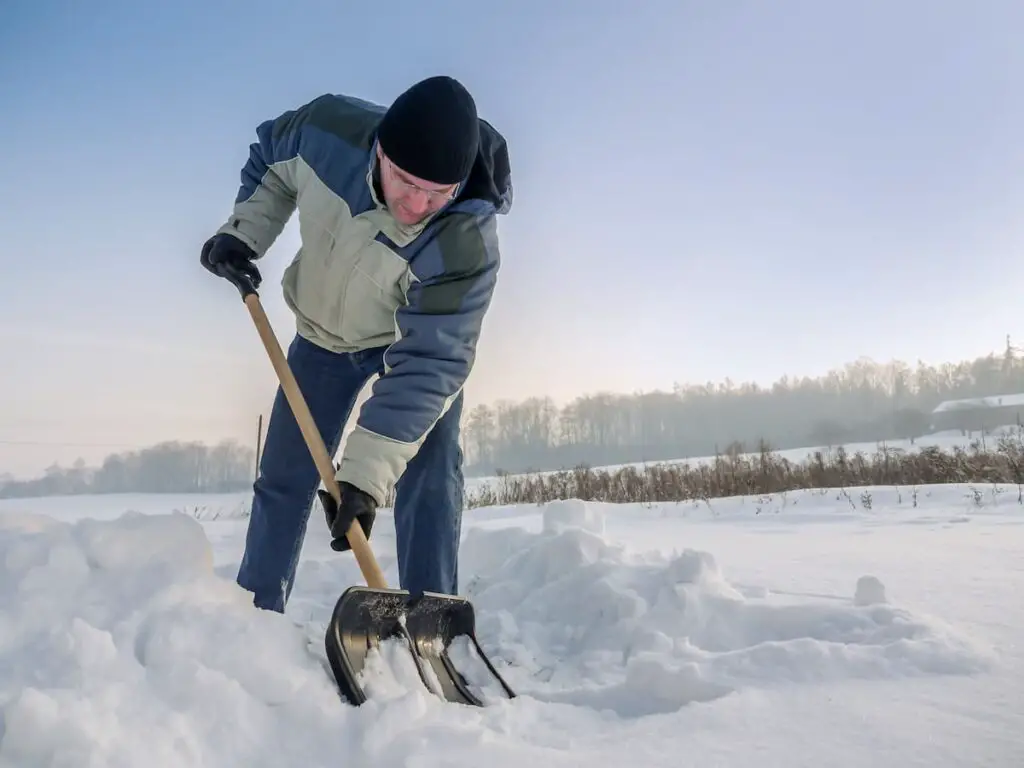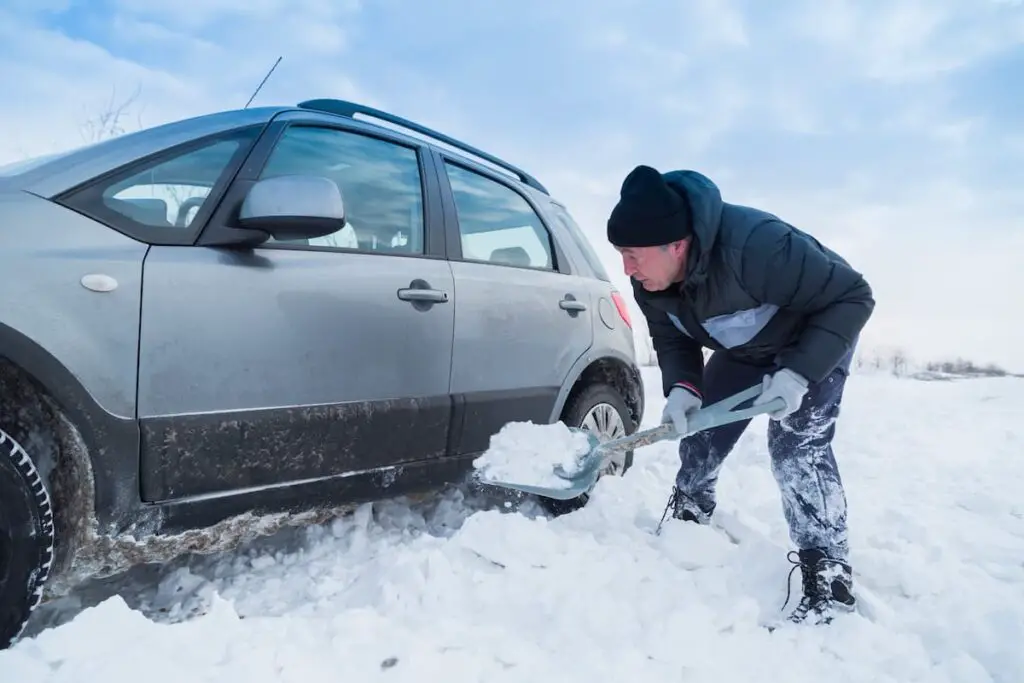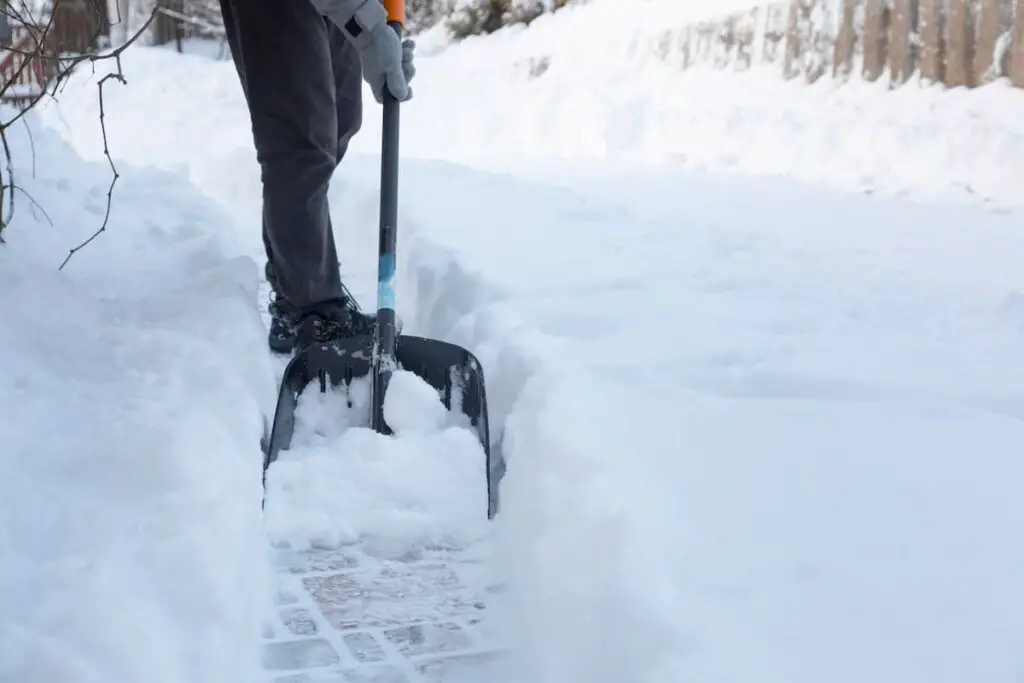As an Amazon Associate, we earn from qualifying purchases. We may also earn commissions if you purchase products from other retailers after clicking on a link from our site.
Few of us enjoy shoveling snow. It can seem pointless — either it’s going to snow again, or the snow will melt on its own. So, perhaps shoveling is a waste of time?
Shoveling snow is not a waste of time. You ought to shovel snow to make a safe pathway, protect your driveway, be considerate, and avoid fines. However, you do not need to shovel snow off your deck, and you should not climb on your roof to shovel snow.
Now that the snow has fallen, it’s time to decide. Are you going to go outside and clear some snow or stay inside? We will go over the pros and cons of shoveling snow and when you should do it or let it be.

Why Should You Shovel Snow?
You should shovel some snow at least to create pathways for safe traveling — such as from the front door to your car. Tempting as it might be to wait for it to melt, you have no way of knowing if you will need to leave your home in an emergency.
Here are some reasons to shovel the white flakes before they turn into ice:
To Make a Safe Pathway
There are some advantages to shoveling snow, at least to make a pathway. Although fresh snow has traction, the snow becomes slippery once it gets packed down. In addition, when the temperatures rise during the day, some of that snow turns into water or mush.
However, if the water fails to evaporate, when temperatures drop at night, the freezing water will turn to ice. Then you will have slippery ice to contend with.
To Protect Your Driveway
Shoveling your driveway will protect it from additional wear and tear. As the water melts, it seeps into your driveway’s cracks and crevices. Should the water freeze again, the expanding ice can cause additional damage to your driveway.

To Be Considerate
You might not care if your sidewalk or walkway is covered in snow or ice, but you aren’t the only one who might use it. If you’re inviting people over, keep in mind that they might not be up to walking on ice.
And what about the delivery person or mailman? Make their day by keeping a snow and ice-free pathway to your home.
To Avoid Fines
Many towns fine homeowners who do not shovel the sidewalk in front of their house. Since the city will be busy clearing snow, fines are often issued if someone complains. Therefore, if your neighbors shovel their sidewalk, a pedestrian who has to navigate your sidewalk will be more likely to call in a complaint.
Also, your town might have rules about blocking a fire or shoveling into the street. For a state-by-state listing of state snow removal laws, consult this Rentec Direct site. Although the site is geared toward rental managers, the rules apply to homeowners too.
When Should You Not Shovel Snow?
You should probably not shovel during a blizzard or hailstorm. Additionally, you don’t need to shovel your deck, and you should not shovel your roof either.

Shoveling Snow Can Damage Your Deck
Shoveling snow off your deck can damage it. Accidentally gouging your deck or scraping the wood are two potential ways to damage it.
Your deck can handle a lot of snow before collapsing. Building codes require decks to hold as much snow as a roof. Therefore, the snow’s weight is not likely to cause an adequately constructed deck to collapse.
Whether your deck is made from wood or synthetic decking, the snow won’t damage either. Wood is naturally moist and must be dried before being used for deck construction. And the wood on your deck is treated to prevent rot.
The summer sun that dries the decking is more harmful to the wood.
Synthetic decking is also not affected by snow. Any shrinkage due to cold will be followed by expansion once the temperature turns warmer.
There are two exceptions to this. First, you should shovel enough snow so that you can exit through the rear door. Clear a 3 foot (0.91 meter) wide path, paying attention to the stairs and railings to avoid slipping.
The second exception is if the snow has reached the rails. In this case, you should get ready to remove some snow.
You Should Not Shovel the Snow From Your Roof
Even if you think your roof is holding too much snow, you should not shovel it off yourself. It is dangerous for you to be on the roof. Furthermore, the additional weight can damage the roof more than the snow itself.
Here are several reasons why you shouldn’t climb on the roof:
- A ladder can easily slip over frozen ground; it could slide from under you if not securely fastened.
- Your shoes may slip on the ladder or the roof.
- You can harm the shingles — because shingles become brittle in cold conditions, they are more likely to shatter when you step on them.
- You’re more likely to knock off the granules on the shingle’s surface, reducing the roof’s lifespan.
Your Roof Can Hold More Snow Than You Think
Your roof is built to withstand snow loads that are typical for the state or region you reside in. Roofs in New York, for example, need to be built to hold 25 to 35 pounds (11.33 to 15.87 kg) of snow on a roof per square foot.
- Fresh snow: One foot of fresh snow equals around 5 pounds (2.26 kg) per square foot of roof area. Therefore, a well-built roof can handle up to 4 feet (1.21 meter) of new snow before getting stressed.
- Packed snow: 3-5 inches (7.62-12.7 cm) of old snow weigh around 5 pounds (2.26 kg) per square foot. Thus, your roof can’t handle more than 2 feet (0.6 meter) of packed snow.
- Ice: An inch of ice weighs the same as a foot of fresh snow.
Also, consider this — a person walking on a roof will add to the total weight on the roof. For example, if 1 square foot (0.09 square meter) of snow weighs approximately 30 pounds (13.6 kg), a 170-pound (77.11-kg) man adds more weight than the snow.
Bottom line: If you have a newer roof in good repair, 2 feet (0.6 meter) of snow should not damage it. And depending on how steep your roof is, the snow might start sliding off after 2 feet (0.6 meter).
Final Thoughts
Because you need to be able to leave your home, you should shovel enough snow to create a pathway. Unfortunately, waiting for the snow to melt is a recipe for ice to develop overnight. If you don’t want to shovel it, hire some neighborhood kids. Remember that the longer you wait, the more snow you’ll have to deal with.
